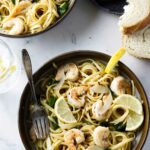Lemon Basil Shrimp Pasta
Lemon basil pasta with shrimp is absolutely full of flavor. Don't skip the quick marinade! If you cook the pasta and start the sauce while the shrimp soaks up all that garlic and lemon goodness, this recipe comes together in 30 minutes.
Servings: 8 servings
Ingredients
Marinate the Shimp
- 1 pound large shrimp peeled and deveined
- 6 garlic cloves finely minced
- ¼ cup fresh lemon juice zest the lemons before juicing them
Make the Pasta
- ½ teaspoon salt
- 1 pound linguine or your choice of pasta
- ¼ cup olive oil
- 1 shallot minced (or half a small onion)
- 1 tablespoon lemon zest
- ½ teaspoon crushed red pepper flakes
- ¾ cup dry white wine or vermouth
- ¼ cup chicken broth
- 4 tablespoons butter cubed
- 1 cup grated parmesan cheese
- 2 bunches fresh basil leaves roughly chopped or torn
Instructions
- Toss the shrimp, garlic, lemon juice, and salt in a bowl and chill in the fridge for 20 minutes.
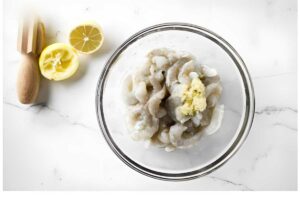
- Add a generous amount of salt to a large pot of water and bring it to a boil. Cook the pasta following the package directions until it reaches an al dente texture. Before draining, make sure to reserve 1 cup of the pasta cooking water. Then, drain the pasta and set it aside for later.
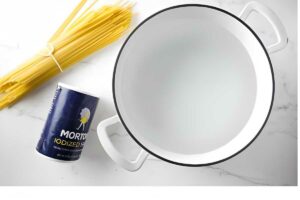
- Heat ¼ cup olive oil in a large skillet over medium high heat. Add the shallot (or onion), lemon zest, and red pepper flakes. Cook until the shallot or onion is soft.
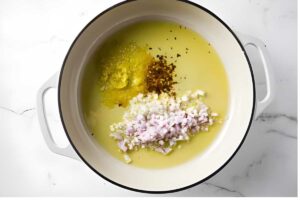
- Add the wine or vermouth and chicken broth and bring to a simmer. Cook until the liquid has reduced by about half, then add the butter.

- Transfer the shrimp to the skillet, including the garlic and lemon juice from the marinade.
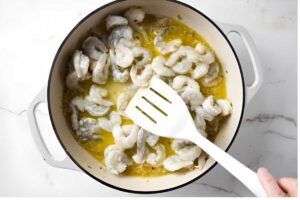
- Cook for about 60 seconds or until just barely cooked through. Add the cooked pasta to the skillet. Toss and continue cooking for 60 to 90 seconds or until the shrimp is finished cooking. The sauce will be watery at this point.
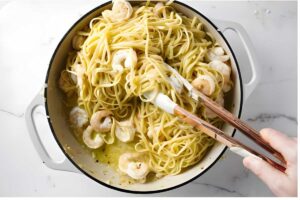
- Remove the skillet from the heat and stir in the Parmesan. Toss until well coated and the sauce starts to thicken. Add the basil and toss once more. If you want the sauce thinner and ‘saucier’, add ¼ to ½ cup of the reserved pasta water.
Notes
Salt the pasta water: Use about 1 tablespoon of salt for every 4 quarts of water so the pasta itself is properly seasoned.
Adjust sauce consistency: Stir in reserved pasta water a little at a time until the sauce reaches your preferred thickness.
Choose the right wine: A dry white like Pinot Grigio or Sauvignon Blanc works best. Vermouth is a great substitute for a slightly different flavor.
Zest carefully: Only remove the yellow skin. Avoid the white pith underneath, as it can make the sauce bitter.
Nutrition
Serving: 1 serving | Calories: 389kcal | Carbohydrates: 31g | Protein: 22g | Fat: 18g | Saturated Fat: 7g | Polyunsaturated Fat: 9g | Cholesterol: 146mg | Sodium: 979mg | Fiber: 3g | Sugar: 2g
